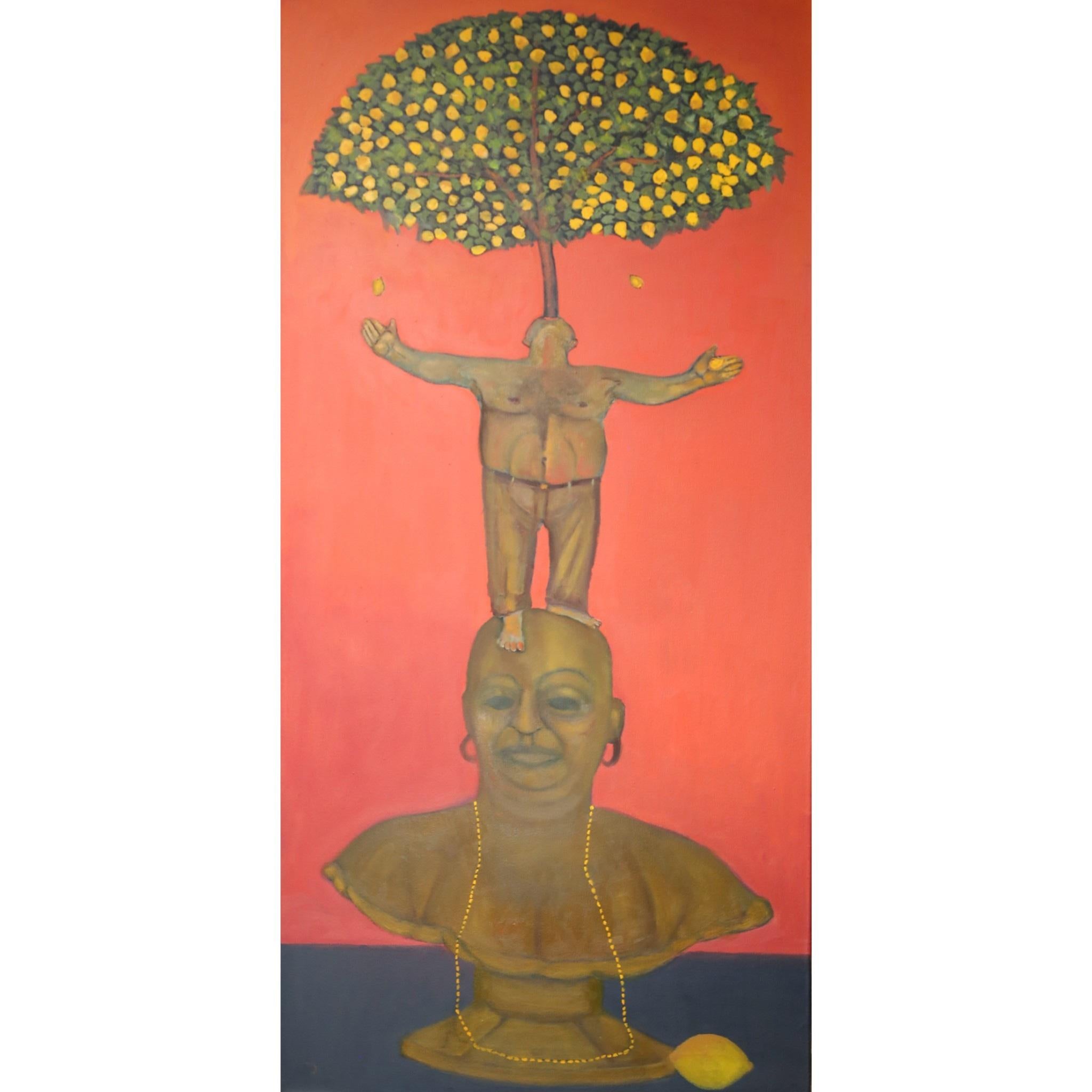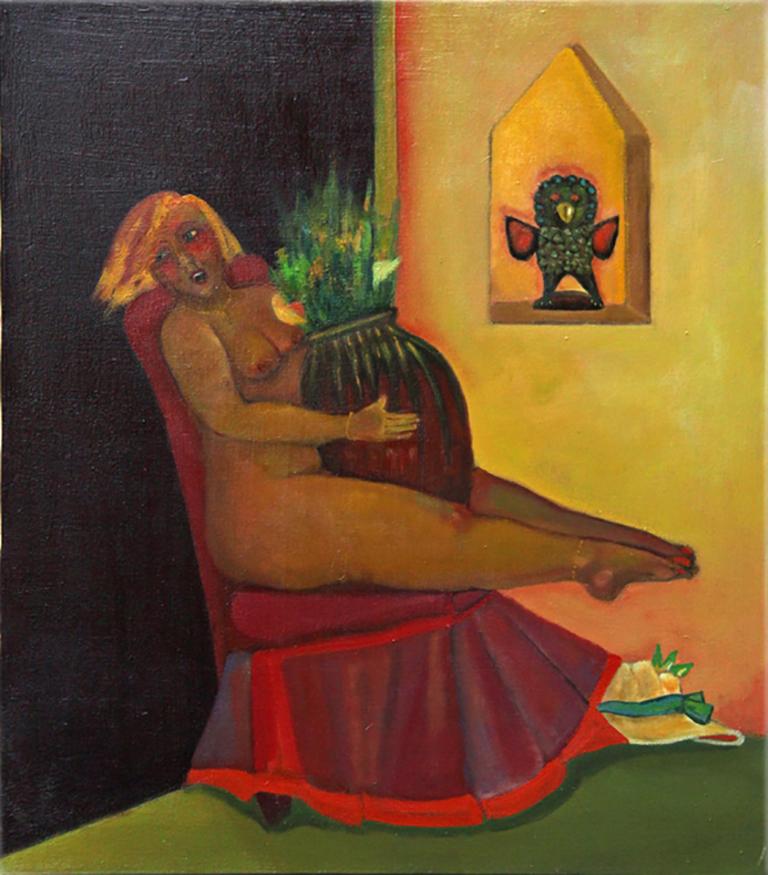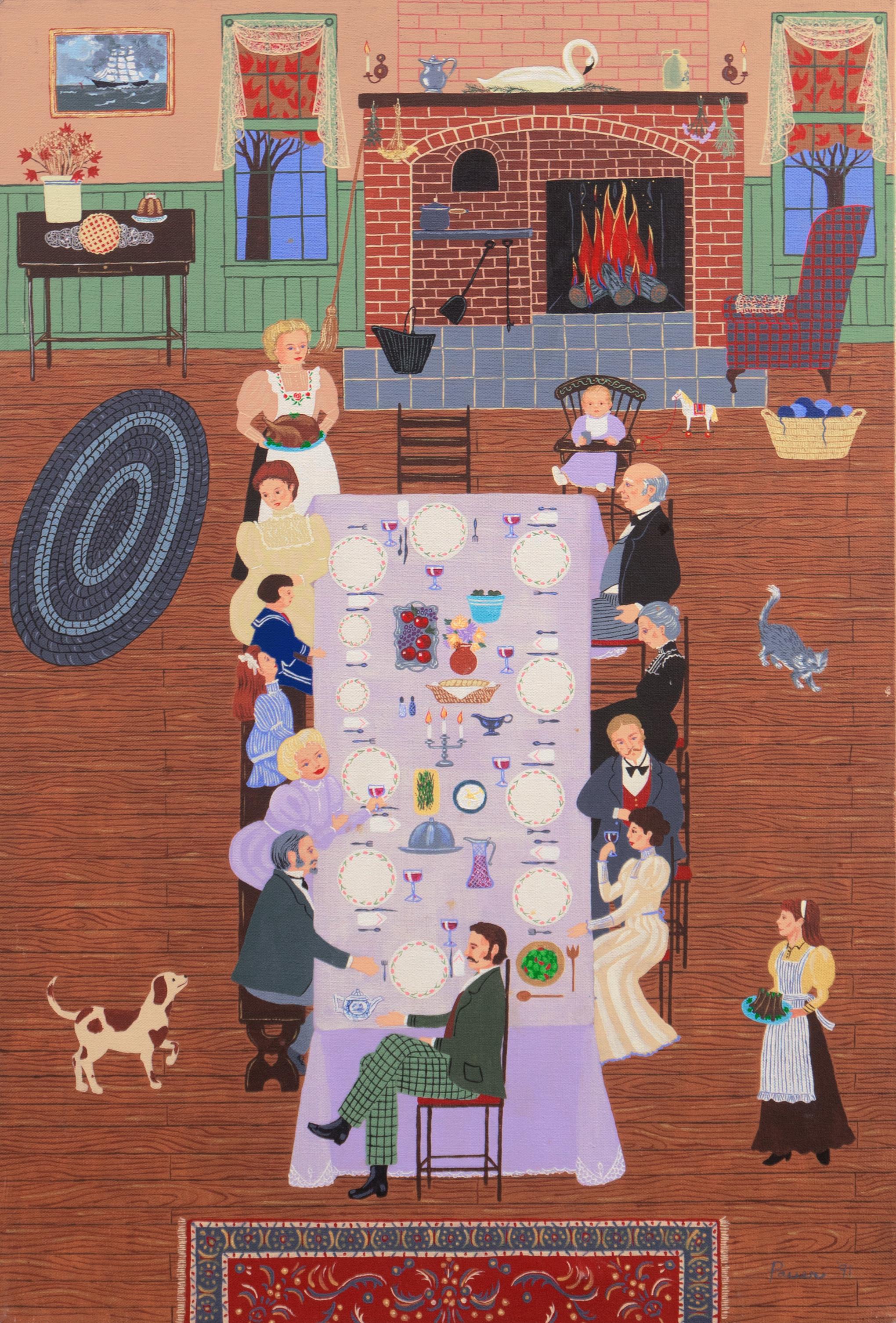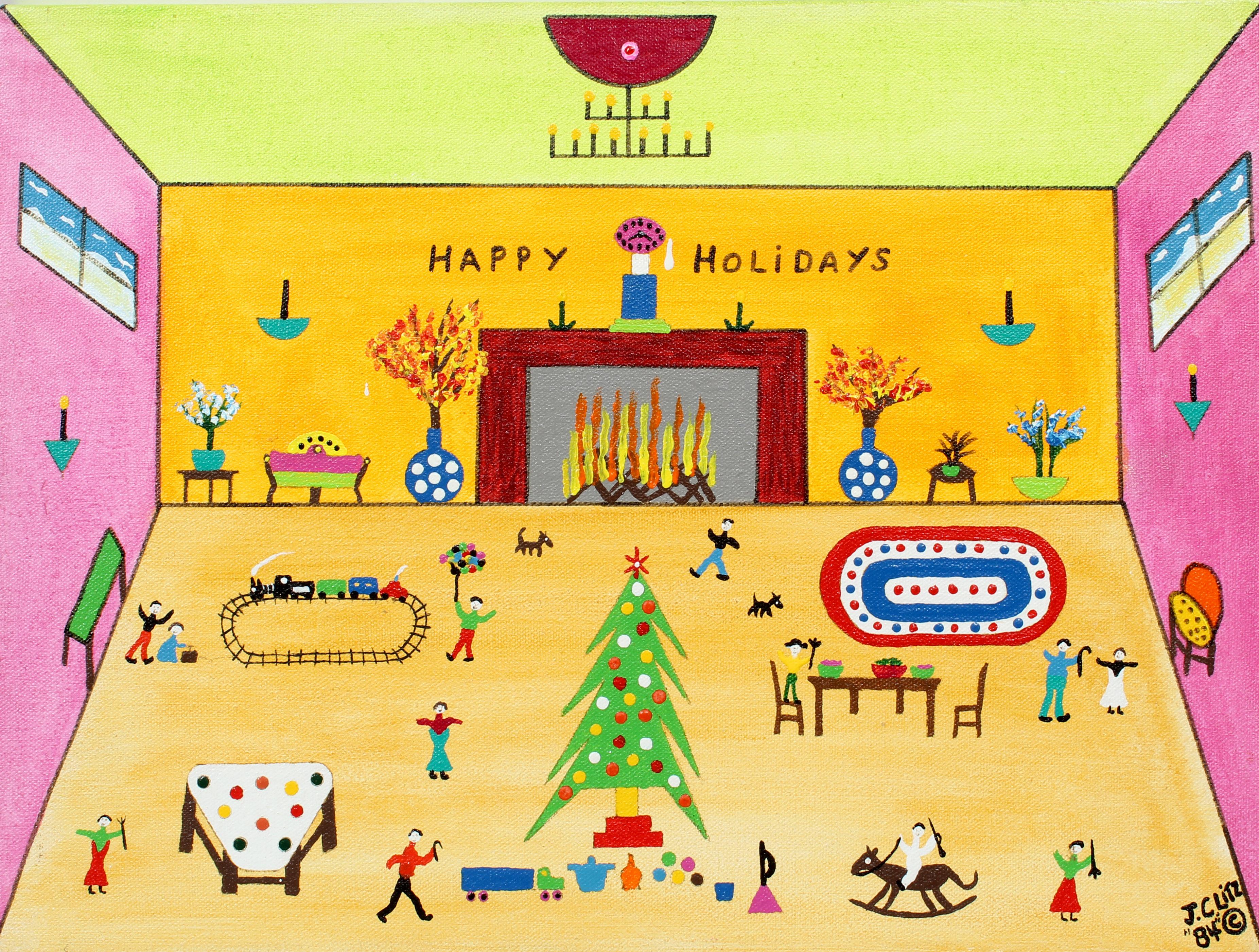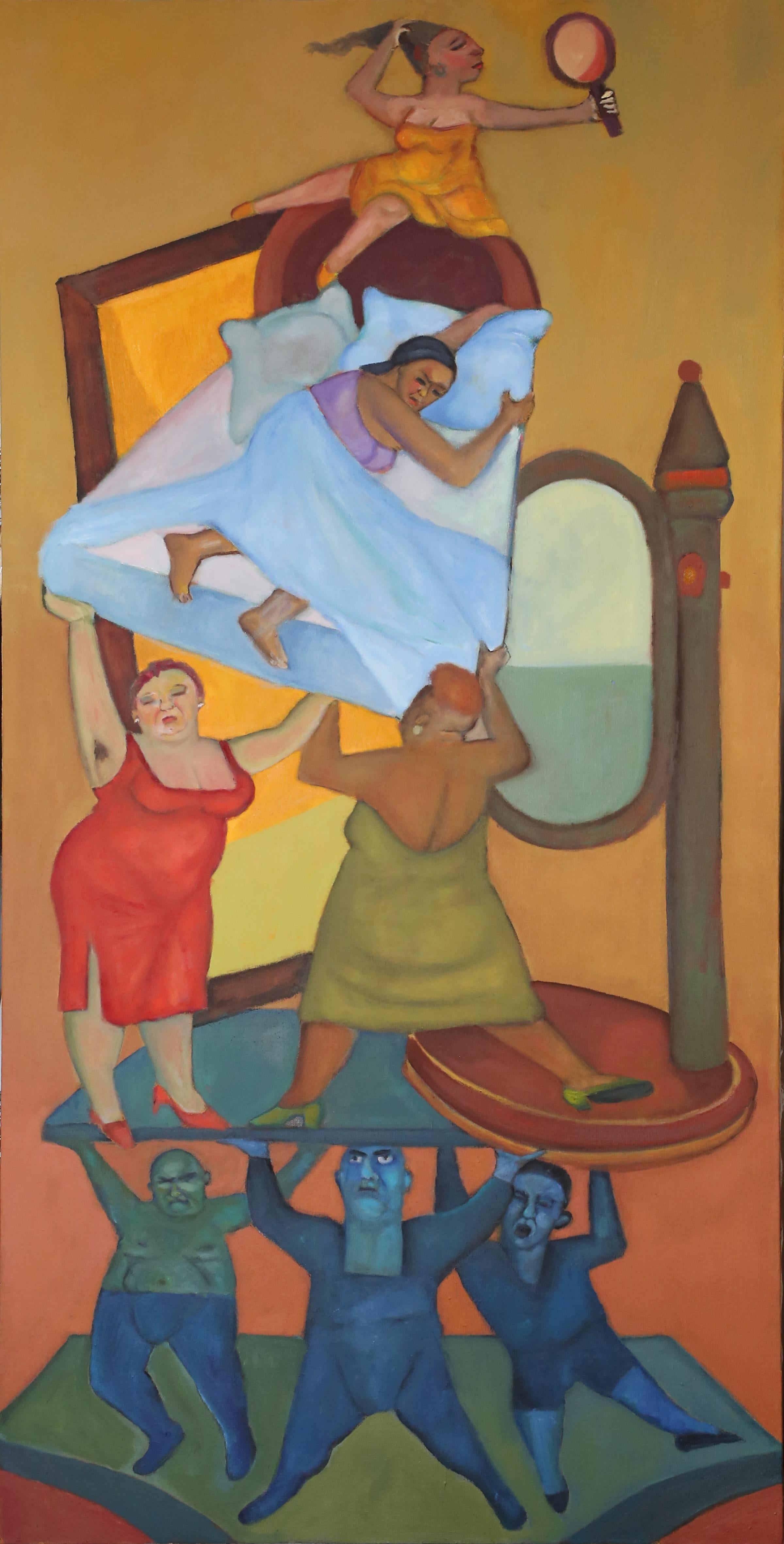Items Similar to "The Marriage Proposal (Family Gathering), " Leo Schutzman, Jewish Folk Art
Want more images or videos?
Request additional images or videos from the seller
1 of 9
Leo Schutzman"The Marriage Proposal (Family Gathering), " Leo Schutzman, Jewish Folk Artcirca 1958
circa 1958
About the Item
Leo Schutzman (1878 - 1962)
The Marriage Proposal, circa 1958
Oil on canvas
24 x 20 inches
Signed lower left
Leo (Kyle) Schutzman (1878-1962) developed a reputation in New York in the 1950s as the ‘Jewish Grandma Moses.’ The characterization was particularly appropriate. Both artists only took up painting in a serious way in their old age after retiring from work. They also shared a popular aesthetic style then known as ‘primitivism’ or ‘naive art,’ far from the abstract expressionism that was the art critic’s darling at the time.
Schutzman was born Leo Kyle in Russia around 1878. His father died when he was 3 years old and he immigrated to England in his teens, where he remained for 9 years. When he moved to the United States in 1905, he took the name Schutzman after a German family who was renting to his nephew, Louis Kyle.
In New York City, Schutzman worked in the Jewish-dominated clothing industry, producing underwear as well as lace and embroidery. He founded the Victory Undergarment Company and the business was successful enough to provide for his family until he retired at about age 74.
After retirement, Schutzman took art courses at the Brooklyn Museum and began painting. He often depicted scenes of Jewish religious life that he remembered from childhood in Russia. His work seemed the very definition of ‘naive art’ as it was personified by Grandma Moses in the 1950s. His clumsy human figures sometimes had no features at all, or were portrayed with just a slash for the mouth and two dots for the eyes. He had only the vaguest sense of perspective and often used dissonant colors in unusual places.
Schutzman had his first one-man show in 1958, when he was 80 years old, at The Contemporaries gallery (992 Madison Ave.). His optimistic primitivism was popular in the United States in the 1950s as was his backstory; an immigrant who had succeeded as an entrepreneur in the capitalist system before affirming the democratic individualist creed that everyone had talents and could accomplish something at any age. He was soon socializing at parties with people like heiress/artist Gloria Vanderbilt. One of his ‘non-Jewish’ works depicting a winter carnival was chosen in 1962 for the United Nations Children’s Fund Christmas Card Collection.
When Grandma Moses died in 1961, naive art began to lose popularity Schutzman was living in Glendale Queens when he died at age 83 in 1962 and his reputation soon disappeared. In 1986, two of his paintings were acquired by the Jewish Museum in New York City. One of them, “The Wedding,” (c. 1960) was an iconic portrait of an Ashkenazic wedding. It has been reproduced by the Jewish Museum on popular stationery, and has appeared in popular books such as The Complete Idiot's Guide to Understanding Judaism.
Schutzman had three children, one of whom, Steven Kyle (1913-1979; nee Siegfried Schutzman)), married Betty Comden (1917-2006) in 1942. Comden, along with her writing partner Adolph Green, was the award-winning lyricist of many memorable Broadway and film musicals of the mid-1900s including “Singin’ in the Rain,” “On the Town,” “Peter Pan,” and “The Bandwagon.”
Leo Schutzman never minded the comparisons to Grandma Moses. He actually visited her in 1953 to show her some of his works and receive some advice from the 93-year-old painter. Both artists were noted for expunging the grim realities of life, choosing instead to focus on simple and generally joyful scenes. Schutzman once summed up his philosophy: “It doesn’t make any difference to me what they call my style as long as people enjoy the paintings.”
- Creator:Leo Schutzman (1878 - 1962, American, Russian)
- Creation Year:circa 1958
- Dimensions:Height: 27 in (68.58 cm)Width: 23 in (58.42 cm)
- Medium:
- Movement & Style:
- Period:
- Condition:
- Gallery Location:New York, NY
- Reference Number:1stDibs: LU184129905782
About the Seller
5.0
Platinum Seller
These expertly vetted sellers are 1stDibs' most experienced sellers and are rated highest by our customers.
Established in 2021
1stDibs seller since 2022
59 sales on 1stDibs
Typical response time: 1 hour
- ShippingRetrieving quote...Ships From: Saratoga Springs, NY
- Return PolicyA return for this item may be initiated within 3 days of delivery.
More From This SellerView All
- "The Letter, " Frederick Boston, Woman Reading, American Impressionism FigurativeBy Frederick James BostonLocated in New York, NYFrederick James Boston (1855 - 1932) The Letter Oil on canvas 20 x 16 inches Signed lower left The first instructor of art at the Brooklyn Institute of Arts and Sciences, Frederick ...Category
Late 19th Century American Impressionist Figurative Paintings
MaterialsCanvas, Oil
- "The Doubtful Bill" Charles Blauvelt, 19th Century Genre Painting Money InteriorLocated in New York, NYCharles Blauvelt The Doubtful Bill, 1868 Signed and dated lower left Oil on canvas 12 1/4 x 9 1/2 inches Provenance: Private Collection, Connecticut...Category
1860s Figurative Paintings
MaterialsCanvas, Oil
- "Nude by the Mirror" Mid-Century Modern Expressionist and Cubist FigureBy Byron BrowneLocated in New York, NYByron Browne (1907 - 1961) Nude by a Mirror, 1958 Oil on canvas 26 x 20 inches Signed lower right Provenance: Doyle New York, Doyle + Design, June 7, 2017, Lot 20 Born in Yonkers,...Category
1950s American Modern Interior Paintings
MaterialsCanvas, Oil
- "A Quiet Afternoon, " Enoch Wood Perry, Genre Scene Mother and Child at FireplaceBy Enoch Wood Perry Jr.Located in New York, NYEnoch Wood Perry, Jr. (1831 - 1915) A Quiet Afternoon, 1876 Oil on canvas 15 1/4 x 21 inches Signed and dated lower right Born in 1831 in Boston, Enoch Wood Perry, Jr, is internatio...Category
1870s Hudson River School Interior Paintings
MaterialsCanvas, Oil
- "Three Engineers, " Albert Pels, Men at Table with Compass, WPA, American RealismBy Albert PelsLocated in New York, NYAlbert Pels (1910 - 1998) Three Engineers, circa 1935 Oil on board 10 x 13 1/2 inches Signed lower right Albert Pels was an art educator and painter of figures, genre scenes, urban ...Category
1930s American Realist Figurative Paintings
MaterialsOil, Board
- "Interior of a Stable" William Hart, Hudson River School Antique, Boy and HorseBy William HartLocated in New York, NYWilliam M. Hart (1823 - 1894) Interior of a Stable Oil on canvas 17 x 12 inches Provenance William Macbeth Gallery, New York Mrs. Mabel Brady Garvan Collection Christie's New York, Sporting Art, November 28, 1995, Lot 116 Ann Carter Stonesifer, Maryland Estate of above Brunk Auctions, Asheville, North Carolina, January 27 2018, Lot 777 Exhibited New York, The Metropolitan Museum of Art, Life in America, April 24 - October 29, 1939, no. 123, illustrated. New York, Macbeth Gallery, 1892: Sixtieth Anniversary Exhibition, April 1952, p. 5, no. 18. Literature Turner Reuter Jr, Animal and Sporting Artists in America, Middleburg, Virginia, 2008, p. 306. Gary Stiles, William Hart: Catalogue Raisonné and Artistic Biography, no. 1126, illustrated. It should be noted that the Francis Patrick Garvan and Mrs. Mabel Brady Garvan collection, of which this painting was a part of, was one of the foremost American Art collections and now makes up a large part of the Smithsonian American Art Museum and the Yale University Art Gallery collections. Born in 1823 in Paisley, Scotland, William Hart emigrated with his parents to the United States at the age of nine and settled in Albany, New York. It was here that Hart first began his artistic training when he was placed under the tutelage of Messrs, Eaton & Gilbert, the prestigious coach-makers from Troy, New York. During this time, Hart learned how to decorate coach panels, covering them with either landscapes or figurative compositions. At the age of seventeen, he was eagerly contemplating an artist’s profession. Consequently, he left the mechanical trade of coach-making and began expanding his artistic pursuits to more refined endeavors. Hart followed coach-making with decorating window shades and later developed an interest in portraiture. Around 1840, he established his first formal studio in his father’s woodshed in Troy. There, he created many likenesses of individuals, affording him a nominal income. Once, he remarked that he felt prouder over his first fee of five dollars for painting a head then for the larger sums he would command later in his career. Nevertheless, his wages from portraits during this early period proved insufficient. Thus, he expanded into landscape painting, allowing him to barter his works or sell them for modest prices. In 1842, Hart moved to Michigan in an attempt to further his success; portraiture remained his primary means of support. Unfortunately, his experiences in the West were disappointing. Hart spent three years living a rough existence until he finally returned to Albany in 1845. Upon his return, he fully devoted himself to the art of landscape painting. Despite his failing health, he worked diligently to perfect his skill until 1849 when he traveled abroad to his native land of Scotland. This trip was made possible through the generosity of his patron and advisor, Dr. Ormsby of Albany. For three years, he studied in the open-air, creating brilliant sketches of the Scottish Highlands and the surrounding British Isles. Returning to Albany once more in 1852, Hart enjoyed improved health and was reinvigorated with purpose. The following year, he moved to New York and opened a studio, promoting himself as a specialist in landscape painting. Hart became a regular contributor to the National Academy of Design. His works received a great deal of attention from artists and connoisseurs alike, all of whom praised him for his fresh, self-taught style. In 1855, he was designated as an associate of the National Academy of Design; three years later he was elected to Academician. In 1865, he was unanimously chosen to be the first president of the Brooklyn Academy of Design. It was during his tenure there that he delivered his famous lecture The Field and Easel, which emphasized the distinguishing principles of landscape art in America. Hart argued that landscape painters should express the “look of the place” being depicted.Critics during the 1870s noted his sensitive balance between capturing a strict “real” interpretation of nature and that of a more “ideal” sentimental tone. For instance, in 1869, Putnam Magazine noted that Hart brought back “exquisite studies” of the surrounding Tappan...Category
19th Century Hudson River School Animal Paintings
MaterialsCanvas, Oil
You May Also Like
- Soutine's Purveyor, humorous butcher with meat, foodBy Stephen BassoLocated in Brooklyn, NYStephen Basso's highly original pastels and oil paintings are romantic, yet thought provoking fantasies. His whimsical works are alive with boundless imagination, wry wit and fear...Category
2010s Outsider Art Figurative Paintings
MaterialsCanvas, Oil
- Antique Lemondrops persimmon red and rich gold ochre colors interior subjectsBy Stephen BassoLocated in Brooklyn, NYFirst of a series of totem like images by the artist dealing with everyday objects. Oil on canvas titled signed and dated on reverseCategory
2010s Outsider Art Figurative Paintings
MaterialsCanvas, Oil
- Nude on the Edge#2, colorful, whimsical imaginative nudeBy Stephen BassoLocated in Brooklyn, NY*ABOUT Stephen Basso Stephen Basso's highly original pastels and oil paintings are romantic, yet thought provoking fantasies. His whimsical works are alive with boundless imagina...Category
2010s Outsider Art Figurative Paintings
MaterialsCanvas, Oil
- 'The Family Dinner', Thanksgiving, Christmas, Festive Reunion, Large Naive OilLocated in Santa Cruz, CASigned lower right, 'Pauer' for Jacalyn Pauer (American, 20th century) and dated 1991. Additionally signed, verso, and titled, 'The Family Dinner'. A su...Category
1990s Folk Art Interior Paintings
MaterialsCanvas, Acrylic
- Holiday Folk Art Painting Toys Interior James Litz American Naive Rare ChristmasBy James C. LitzLocated in Buffalo, NYA thoroughly charming original acrylic on canvas painting by American folk art artist James C. Litz. Perfect as a holiday gift or a wonderful adornment for your own home, this impo...Category
1990s Folk Art Interior Paintings
MaterialsCanvas, Acrylic
- Tower of Slumber fantasy male and female figures engaged in Hercularian feats.By Stephen BassoLocated in Brooklyn, NYThis painting is one of various works by the artist depicting narratives in a narrow vertical format primarily influenced by the works of the German artist Max Beckmann . It is a lar...Category
2010s Outsider Art Figurative Paintings
MaterialsLinen, Oil

